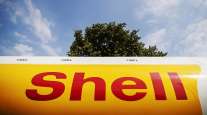Senior Reporter
Natural Gas Remains Viable for Trucking, Advocates Say

This story appears in the Oct. 10 print edition of Transport Topics.
LAS VEGAS — It’s the “second inning” of the natural gas industry’s involvement with the transportation industry, especially the heavy-duty truck sector, key advocates of the leading alternative fuel to diesel said.
They made the comments Oct. 3 at a meeting here during American Trucking Associations’ Management Conference & Exhibition.
“It is a tough market right now for natural gas with diesel prices down, truck cycles are in the bottom, it’s an election year and a lot of [fleet] people are resistant to change,” said Rob Neitzke, president of Cummins Westport Inc., the sole natural-gas engine manufacturer serving the U.S. market.
“But what has not changed is Cummins’ dedication and commitment to the natural-gas engine development and industry, in general,” Neitzke said. “We are continuing to invest more and more on improving the existing engines.”
MCE PHOTO GALLERY: Best pictures from Las Vegas
COMPLETE MCE COVERAGE: Live stories, photos, video, social media and more
Cummins Westport is a joint venture between engine maker Cummins Inc., which is based in Columbus, Indiana, and Westport Innovations Inc., a provider of alternative fuel, low-emissions technologies based in Vancouver, British Columbia.
Meanwhile, the price of fueling systems has fallen because of competition and a continuing build-out of the compressed natural gas fueling infrastructure, as fleets assess and add trucks. But more rapid growth hinges on governments heeding the industry’s wish list, especially for incentives, the advocates said.
Neitzke said the near-zero emissions natural-gas engines beginning to emerge will reclaim the advantage their predecessors once enjoyed over diesel engines that have slashed harmful emissions over the past decade.
The California Energy Commission said in September it approved a $1 million grant to develop a 12-liter natural-gas engine suitable for Class 8 vehicles that produces near-zero nitrogen oxide tailpipe emissions.
A midsize Cummins Westport engine, the 8.9 liter ISL G NZ, has already been certified as 90% lower, or 0.02 gram per brake horsepower-hour, than the current Environmental Protection Agency NOx limit of 0.2 gram, the company said.
In a comment aimed at skeptical fleets, Neitzke said a natural- gas engine shares many facets with its “diesel brother”: the engine block, crankcase and bearings are the same.
“It’s got similar ratings in the torque curve. Both engines are produced at the same [Cummins] manufacturing facilities ... they have the same maintenance intervals,” he said.
Also, the natural-gas industry continues to consolidate.
At the meeting, William Nowicke, chief operating officer at Agility Fuel Systems, announced his company and Hexagon Composites’ CNG Automotive Products Division, which includes medium- and heavy-duty vehicle composite cylinder manufacturing operations and its bus systems business unit, have merged to form Agility Fuel Solutions, which is based in Santa Ana, California.
The new entity is owned equally by Norway-based Hexagon Composites and Agility’s current investors, including Cummins, and have production sites in Brazil, Norway and the United States. The transaction is intended to reduce upfront costs, accelerate commercialization of new products and lead to faster returns on investments, according to a statement from Agility.
Also, Agility, in a pilot project with fleets, is integrating a brand new electronic control unit with its fueling system, Nowicke said.
“So, no longer is this an ancillary thing that sits on the side of the truck in an aftermarket way. What we want to do is get connected with the engine as far as giving the driver real-time information about the fuel system. How it is behaving, [diagnosing] what kind of maintenance does it need ... telematics is a big piece of that,” he added.
Related to the industry’s wish list, in September, Sen. Bill Cassidy (R-La.) and Rep. Tim Ryan (D-Ohio) introduced the Natural Gas Truck Tax Parity Act of 2016. If signed into law, this legislation would provide a permanent 35% exclusion from the 12% federal excise tax for alternative-fueled heavy-duty trucks, said Matthew Godlewski, president of the Washington, D.C.-based advocacy group Natural Gas Vehicles for America.
“Obviously, everybody in the room would like to abolish the [federal excise tax]. I think that is ATA’s position, and it is our position. But in the meantime, let’s work to take that off,” he said.
The future of natural gas relies on three factors, Cummins Westport’s Neitzke said.
“One is the availability of a really affordable clean natural-gas alternative. Then we have to have some regulations that are driving someone to use that technology. And then you have to have incentive money to help them adopt that new technology,” he said.
“We are in the second inning. We will be in the third inning in another few years,” Neitzke said. “It will be a slow adoption.”




